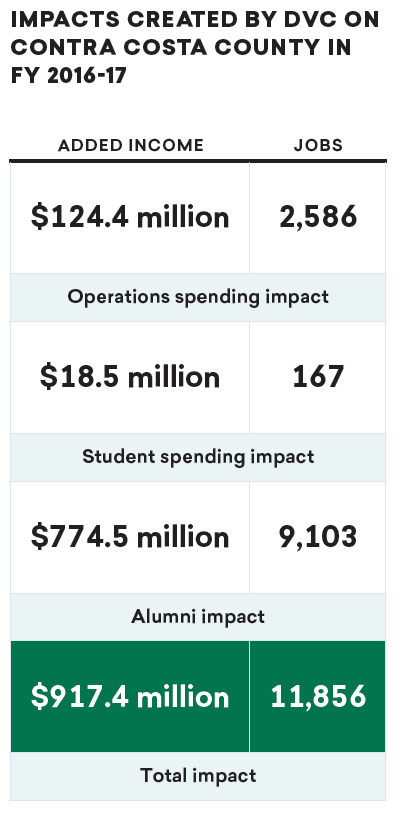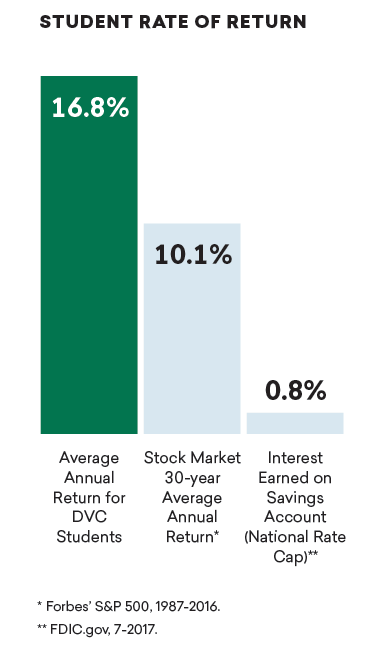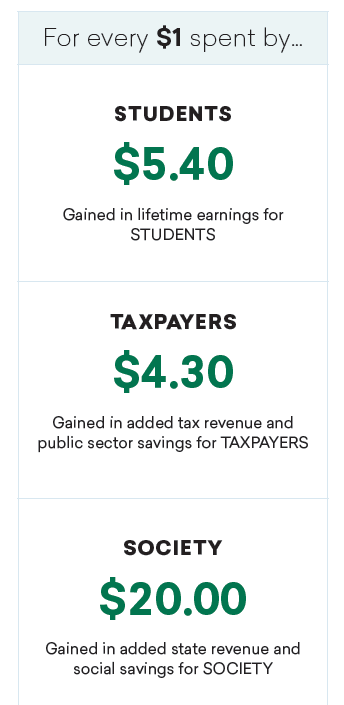The Economic Impact of Diablo Valley College
In the fall of 2018, Diablo Valley College worked with Economic Modeling Specialist International (Emsi) to determine the economic impact Diablo Valley College had on Contra Costa County in fiscal year 2016-17. In December 2018, the report concluded that Diablo Valley College has a significant positive impact on the local economy and is a sound investment from multiple perspectives including students, taxpayers and the community as a whole.
See the The Economic Value of Diablo Valley College on Contra Costa County fact sheet below, or visit EMSI reports for more.
Impact to the business community |
|
 |
During the analysis year, DVC and its students added $917.4 million in income to the Contra Costa County economy, approximately equal to 1.2% of the county’s total gross regional product (GRP). DVC’s impact supported 11,856 jobs in FY 2016-17. The economic impacts of DVC break down as follows: Operations spending impact · DVC employed 2,265 full-time and part-time employees in FY 2016-17. Payroll amounted to $96.2 million, much of which was spent in Contra Costa County to purchase groceries, clothing, and other household goods and services. The college spent another $52.8 million to support its day-to-day operations. · The net impact of college payroll and expenses in Contra Costa County during the analysis year was approximately $124.4 million in income. |
|
Student spending impact · A number of students would have left the county if not for DVC. These retained students spent money on groceries, transportation, rent, and so on at county businesses. · The expenditures of retained students during the analysis year added approximately $18.5 million in income to the Contra Costa County economy. Alumni impact · Over the years, students have studied at DVC and entered or re-entered the workforce with newly-acquired skills. Today, thousands of these former students are employed in Contra Costa County. · The impact of former students currently employed in the county workforce amounted to $774.5 million in added income during the analysis year. |
|
Return on investment to students, taxpayers and society |
|
|
|
Student perspective · DVC’s FY 2016-17 students paid a total present value of $43.9 million to cover the cost of tuition, fees, supplies, and interest on student loans. They also forwent $100.9 million in money that they would have earned had they been working instead of learning. · In return for the monies invested in the college, students will receive a present value of $777.6 million in increased earnings over their working lives. This translates to a return of $5.40 in higher future earnings for every dollar that students invest in their education. The average annual return for students is 16.8%. Taxpayer perspective · In FY 2016-17, state and local taxpayers in California paid $99.3 million to support the operations of DVC. The net present value of the added tax revenue stemming from the students’ higher lifetime earnings and the increased output of businesses amounts to $398.4 million in benefits to taxpayers. Savings to the public sector add another $26.3 million in benefits due to a reduced demand for government-funded services in California.\ · Dividing benefits to taxpayers by the associated costs yields a 4.3 benefit-cost ratio, i.e., every dollar in costs returns $4.30 in benefits. The average annual return on investment for taxpayers is 10.6%. Social perspective · The economic base in California will grow by $5.3 billion over the course of the students’ working lives. Society will also benefit from $71 million in present value social savings related to reduced crime, lower unemployment, and increased health and well-being across the state. · For every dollar that society spent on DVC FY 2016-17 educations, society will receive a cumulative value of $20.00 in benefits, for as long as the FY 2016-17 student population at DVC remains active in the state workforce. |
EMSI Reports
A districtwide report, which includes data from all three colleges in our District, has also been conducted and can be accessed on the District website.



